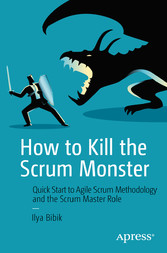Suche
Lesesoftware
Specials
Info / Kontakt
How to Kill the Scrum Monster - Quick Start to Agile Scrum Methodology and the Scrum Master Role
von: Ilya Bibik
Apress, 2018
ISBN: 9781484236918 , 81 Seiten
Format: PDF, Online Lesen
Kopierschutz: Wasserzeichen




Preis: 19,99 EUR
eBook anfordern 
Mehr zum Inhalt

How to Kill the Scrum Monster - Quick Start to Agile Scrum Methodology and the Scrum Master Role
Contents
4
About the Author
5
Acknowledgments
6
Introduction
7
Chapter 1:From Waterfallto Agile
8
Chapter 2: Overview of Agile Methodologies
14
eXtreme Programming
15
Risks and Mitigations
16
Kanban
16
Risks and Mitigations
18
Scrum
18
Risks and Mitigations
18
Hybrid of Different Methodologies
19
Lean
20
Chapter 3: Agile Scrum Deep Dive
21
The Scrum Team
22
How Scope is Divided
24
Sprint Cycle and Meetings
25
Planning Process
27
Definition of Done
28
Board
29
Team Rules
30
Blocks and Impediments
31
Velocity
31
Tools
33
Important to Always Keep in Mind
34
Chapter 4: Scrum Master: What It’s All About
36
Influence Without Authority
37
Scrum Master Admin Work Trap
37
Combining Other Roles with the Scrum Master Role
38
Scrum Master/Developer
38
Scrum Master/Quality
38
Scrum Master/Line Manager
38
Scrum Master/Product Owner/Business Analyst
39
Perceptions, Personalities, and Conditions
39
Commitment of Scrum Master to Additional Tasks
40
Scrum Master Technical Skills
40
Estimating and Monitoring Your Team
41
Accepting Change by the Team
41
Build Scrum Master Confidence
42
Scrum Master = Project Manager?
42
Chapter 5: Team Dynamics
44
Relationships Between Roles in the Team
46
Scrum Master–Product Owner
47
Architect–Product Owner/Architect–Scrum Master
47
Scrum Master–Quality Manager
47
Architect–Developers
47
Scrum Master–Developers
48
Product Owner–Team
48
Technical Writer–Team
48
External-to-Team Communications
49
Team–Line Manager
49
Team–Program
49
Team–Stakeholders
49
Conflict/Problems Resolutions
50
Scrum Master as Part of Conflict
54
Conflict Bottom Line
55
Chapter 6: Key Takeaways
56
Appendix A: Case Studies
58
Situation 1: A Team Member Is Taking Over Responsibilities of Another Role (Not in Order to Help)
58
Background
58
Root Cause
59
Possible Solutions
59
Decision
59
Situation 2: Ineffective Meeting Planning
59
Background
59
Root Cause
60
Possible Solutions
60
Decision
60
Situation 3: Quality Expert Constantly Misses Deadlines
60
Background
60
Root Cause
61
Possible Solutions
61
Decision
61
Situation 4: Another Team Is Trying to Take Over
61
Background
61
Root Cause
62
Possible Solutions
62
Decision
62
Situation 5: Micromanaging Line Manager
62
Description
62
Root Cause
62
Possible Solutions
63
Decision
63
Situation 6: One of the Developers Rejects the ScMa
63
Description
63
Root Cause
63
Possible Solutions
64
Decision
64
Situation 7: PO Isolates Himself from the Team (PO Doesn’t Want to be Part of the Team)
64
Description
64
Root Cause
64
Possible Solutions
65
Decision
65
Situation 8: Conflict Between Teams
65
Root Cause
65
Possible Solutions
65
Decision
66
Situation 9: Lack of Resources in the Team
66
Description
66
Root Cause
66
Possible Solutions
66
Decision
67
Situation 10: Lack of Senior Developers in the Teams
67
Description
67
Root Cause
67
Possible Solutions
67
Decision
68
Situation 11: Team Rejects Agile Scrum Methodology
68
Description
68
Root Cause
68
Possible Solutions
68
Decision
69
Situation 12: Team Wants to Have Longer Sprints of Four Weeks
69
Description
69
Root Cause
69
Possible Solutions
69
Decision
69
Situation 13: Developer in the Team Will Work on Other Developers Tasks Instead of His/Her Own
70
Description
70
Root Cause
70
Possible Solutions
70
Decision
70
Situation 14: PO Fails to Provide Requirements
70
Description
70
Root Cause
71
Possible Solutions
71
Decision
71
Situation 15: Requirements Change During Sprint
71
Description
71
Root Cause
71
Possible Solutions
72
Decision
72
Situation 16: External Stakeholders Try to Change Requirements Directly With Developers
72
Description
72
Root Cause
72
Possible Solutions
73
Decision
73
Situation 17: Not Able to Complete Quality DoD During the Sprint
73
Description
73
Root Cause
73
Possible Solutions
73
Decision
74
Situation 18: A Lot of Nonconstructive Feedback During Retrospective
74
Description
74
Root Cause
74
Possible Solutions
74
Decision
74
Situation 19: Lack of Participation During Retrospective
75
Description
75
Root Cause
75
Possible Solutions
75
Decision
75
Situation 20: Justified Negative Feedback from Stakeholders During Review
75
Description
75
Root Cause
76
Possible Solutions
76
Decision
76
Situation 21: Unjustified Negative Feedback from Stakeholders During Review
76
Description
76
Root Cause
76
Decision
77
Situation 22: Unrealistic Estimates During Planning
77
Description
77
Possible Solutions
78
Decision
78
Situation 23: Can’t Complete Sprint Commitments
78
Description
78
Root Cause
78
Possible Solutions
79
Decision
79
Index
80






